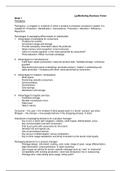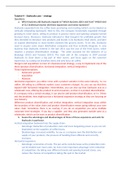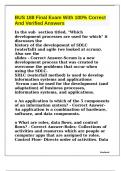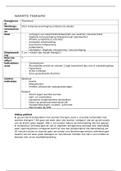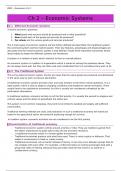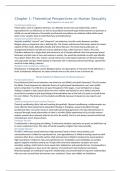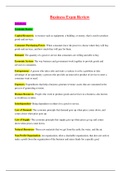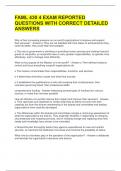çççMarketing Business Vision
Week 1
Packaging
Packaging = a wrapper or container in which a product is enclosed, encased or sealed. It is
needed for: Protection / Identification / Convenience / Promotion / Attraction / Efficiency /
Reputation.
Advantages of packaging differs based on stakeholder:
1. Advantages of packaging for consumers:
- Protects the content.
- Convenient usage and storage.
- Provide necessary information about the products.
- Helps memory and recognition: brand and pack.
- Value for money equation: is the value perceived by consumers?
- Personalization: KitKat my break campaign.
2. Advantages for manufacturers:
- Fulfill basic needs (production): keep the product safe / facilitate storage / enhances
goodwill.
- Help build brand equity (marketing): promotes product / helpful in advertising and
sales promotion / increase profit when value perceived by consumers.
3. Advantages for retailers / wholesalers:
- Shelf space.
- Positioning towards consumers.
- Communication.
- Convenience.
- Cost savings.
- Distribution and storage.
4. Advantages for logistic services:
- Facilitates storage.
- Number of products in box.
- Pallet load.
- Help in transit.
Consumer – the user = the mindset of what people want in a brand / product, pre-store.
Shopper – the chooser = how people behave in the shopping process, in-store.
Importance of packaging decisions for a product manager:
- Key to win in store with shoppers: visibility, shelf impact, differentiation, price.
- Key communication tool with consumers:
First touch point with consumers for the brand.
Develop trial and repeat use.
Use as promotional service.
- Key source of differentiation versus competition.
- Key to drive usage satisfaction and bring innovation to the brand, build loyalty.
Packaging decisions for a product manager:
- Package design: role brand, naming, color code, shape of pack, range differentiation,
legal information, brand protection, in store scanning.
- Use of pack as vehicle for promo, specific message such as “new” or “improved”.
- Compatibility with existing production, need new production line or outsourcing.
- Package size: retail selling price usage, family pack?
, - Package cost relating to total COGS and targeted profitability.
- Package test and sustainability needed.
Different types of packaging projects:
Redesigning of physical pack:
- Add a new convenience, create an ownable shape.
- Usually impact on production and would need capital investment.
Redesigning of brand packaging:
- Brand design evolution.
- Usually no impact on production, nor need for capital investment.
New packaging for a line extension:
- Adapt brand design.
- Can have impact on production and need for capital investment if physical pack is
different.
Promotional pack:
- Use pack to communicate promotion, off price, recipes, contest.
DMS: Digital Marketing Audit
Digital marketing strategy = the series of actions that help you achieve your company goals
through carefully selected online marketing channels. These channels include paid, earned,
and owned media, and can all support a common campaign around a particular line of
business.
Digital marketing fundamentals:
- New media = means of mass communication using digital technologies such as the
internet.
- Digital marketing = technologies using digital formats and internet.
This can range from computer, to mobile, to digital billboards. In encompasses online shared
experience such as social media or digital marketing software that helps marketers create,
distribute and track their campaign on digital platforms.
Inbound (pull strategy) = attracts leads by providing content that is
helpful and will organically lead to engagement.
E.g. blogs / PR / SEO / word of mouth / social media / forums etc.
Outbound (push strategy) = show content to as many users as
possible to increase chances of reaching an interested audience.
E.g. tv advertisement / sales flyers / spam / cold-calling / radio etc.
Types of media:
- Owned = media that you create and have control over. E.g. website / blog / social
channels.
- Paid = paying to drive traffic, conversion and lead creation to owned media. E.g.
social ad / SEA / paid influencers.
- Earned = free publicity generated by consumers, PR agencies, and influencers who
speak about your brand or product. More long-term, doesn’t go away like paid. E.g.
product placement influencer / reviews.
Week 1
Packaging
Packaging = a wrapper or container in which a product is enclosed, encased or sealed. It is
needed for: Protection / Identification / Convenience / Promotion / Attraction / Efficiency /
Reputation.
Advantages of packaging differs based on stakeholder:
1. Advantages of packaging for consumers:
- Protects the content.
- Convenient usage and storage.
- Provide necessary information about the products.
- Helps memory and recognition: brand and pack.
- Value for money equation: is the value perceived by consumers?
- Personalization: KitKat my break campaign.
2. Advantages for manufacturers:
- Fulfill basic needs (production): keep the product safe / facilitate storage / enhances
goodwill.
- Help build brand equity (marketing): promotes product / helpful in advertising and
sales promotion / increase profit when value perceived by consumers.
3. Advantages for retailers / wholesalers:
- Shelf space.
- Positioning towards consumers.
- Communication.
- Convenience.
- Cost savings.
- Distribution and storage.
4. Advantages for logistic services:
- Facilitates storage.
- Number of products in box.
- Pallet load.
- Help in transit.
Consumer – the user = the mindset of what people want in a brand / product, pre-store.
Shopper – the chooser = how people behave in the shopping process, in-store.
Importance of packaging decisions for a product manager:
- Key to win in store with shoppers: visibility, shelf impact, differentiation, price.
- Key communication tool with consumers:
First touch point with consumers for the brand.
Develop trial and repeat use.
Use as promotional service.
- Key source of differentiation versus competition.
- Key to drive usage satisfaction and bring innovation to the brand, build loyalty.
Packaging decisions for a product manager:
- Package design: role brand, naming, color code, shape of pack, range differentiation,
legal information, brand protection, in store scanning.
- Use of pack as vehicle for promo, specific message such as “new” or “improved”.
- Compatibility with existing production, need new production line or outsourcing.
- Package size: retail selling price usage, family pack?
, - Package cost relating to total COGS and targeted profitability.
- Package test and sustainability needed.
Different types of packaging projects:
Redesigning of physical pack:
- Add a new convenience, create an ownable shape.
- Usually impact on production and would need capital investment.
Redesigning of brand packaging:
- Brand design evolution.
- Usually no impact on production, nor need for capital investment.
New packaging for a line extension:
- Adapt brand design.
- Can have impact on production and need for capital investment if physical pack is
different.
Promotional pack:
- Use pack to communicate promotion, off price, recipes, contest.
DMS: Digital Marketing Audit
Digital marketing strategy = the series of actions that help you achieve your company goals
through carefully selected online marketing channels. These channels include paid, earned,
and owned media, and can all support a common campaign around a particular line of
business.
Digital marketing fundamentals:
- New media = means of mass communication using digital technologies such as the
internet.
- Digital marketing = technologies using digital formats and internet.
This can range from computer, to mobile, to digital billboards. In encompasses online shared
experience such as social media or digital marketing software that helps marketers create,
distribute and track their campaign on digital platforms.
Inbound (pull strategy) = attracts leads by providing content that is
helpful and will organically lead to engagement.
E.g. blogs / PR / SEO / word of mouth / social media / forums etc.
Outbound (push strategy) = show content to as many users as
possible to increase chances of reaching an interested audience.
E.g. tv advertisement / sales flyers / spam / cold-calling / radio etc.
Types of media:
- Owned = media that you create and have control over. E.g. website / blog / social
channels.
- Paid = paying to drive traffic, conversion and lead creation to owned media. E.g.
social ad / SEA / paid influencers.
- Earned = free publicity generated by consumers, PR agencies, and influencers who
speak about your brand or product. More long-term, doesn’t go away like paid. E.g.
product placement influencer / reviews.



